Socio-ecological production landscapes in Cuchillas del Toa Biosphere Reserve
26.06.2012
-
SUBMITTED ORGANISATION :
-
Bioversity International, Institute of Fundamental Researches on Tropical Agriculture (INIFAT)
-
DATE OF SUBMISSION :
-
26/06/2012
-
REGION :
-
Caribbean
-
COUNTRY :
-
Republic of Cuba (Cuchillas del Toa Biophere Reserve (RBCT))
-
SUMMARY :
-
Cuchillas del Toa Biophere Reserve (RBCT) has the major conservation levels of endemism and sweet water reserve of Cuba and the Caribbean area. The region constitutes the last refuge of some of the Cuban enigmatic vertebrates, as the manatee and the ivory-billed woodpecker, and other zoological groups, as Polymita spp. In the traditional agricultural systems, the rural communities manage an agrobiodiversity of inestimable value for the genetic resources of the country. Each family uses more than 60 species among wild and cultivated, keeping a remarkable harmony with nature around the Reserve. Farmers recollect dry branches from the forest and with this activity they replace 95% of their fuel needs for elaborating foods and this activity avoids the excessive accumulation of dry matter and the occurrence of fires in the forest. The water that communities use is obtained from natural sources, and also by collecting rain water used for housework and cultivation. Farmers also undertake an agroecological management that contributes to the sustainable production in these systems: they take advantage from the crops, animal and human residuals to produce compost and vermicompost. The traditional knowledge is transmitted through the generations; however, community registers of the local diversity don't exist in the RBCT, which constitutes a threat for its conservation. It is important to implement initiatives that support the documentation of on-farm diversity as a base key for the retrieval of traditional knowledge and for its conservation in the future.
-
KEYWORD :
-
Agricultural biodiversity, biosphere reserve, traditional systems
-
AUTHOR:
-
Yanisbell Sánchez In situ conservation specialist. Cuban contact for IPSI. Institute of Fundamental Researches on Tropical Agriculture (INIFAT). Cuban Ministry of Agriculture Leonor Castiñeiras, Odalys Barrios, Alejandro González, Maribel González-Chávez, Dalila de Armas, Alfredo Socorro & Raúl Cristóbal In situ conservation specialist (INIFAT) Celerina Giraudi3, Gerardo Begué Biologist. Guantanamo Environmental Services Unit (USAG). Cuban Ministry of Science and Technology
-
LINK:
For more details, please refer to the link below.

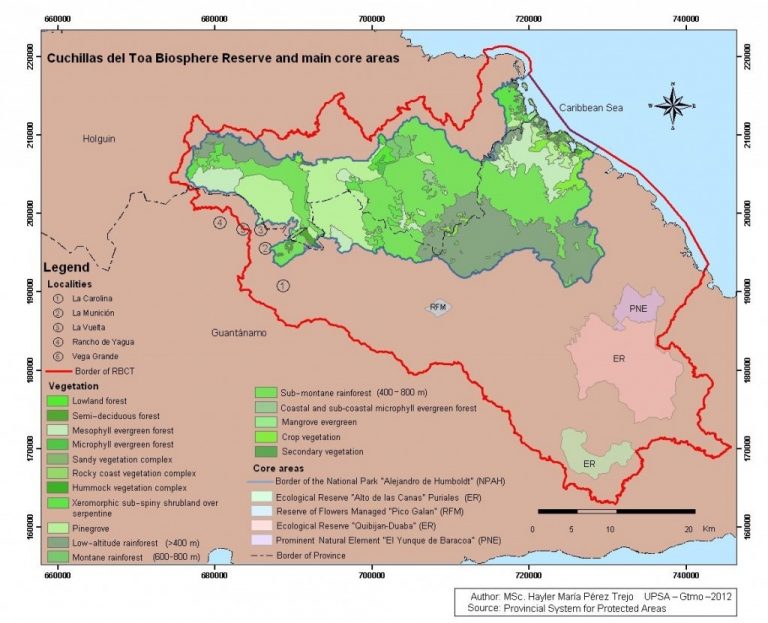
Introduction
Nowadays the world population is estimated to number 7 billion, and perhaps, will reach more than 9 billion in this century. In order to survive as a species on a finite planet, human beings must learn to integrate more harmoniously with the natural systems for a mutual preservation. To this end, it is important to recognize the positive experiences and learn from them, so that both current and future generations can set good rules to preserve the environment and man himself as a biocultural entity.
In Cuba, there is a remarkable synergy between the Ministry of Agriculture (MINAG) and the Ministry of Science, Technology and Environment (CITMA). This has allowed the country to preserve and expand different models of agriculture that are not in conflict with the conservation of the environment, but represent a further component of the biodiversity of ecosystems and landscapes.
The Cuban National Protected Areas System (SNAP) integrates a set of land and sea areas with different management categories. Currently, these areas represent 20% of the terrestrial surface and they are protected by both CITMA and MINAG.
Within Cuban protected areas, the six Biosphere Reserves have a prominent role. One of them, the Cuchillas del Toa Biosphere Reserve (RBCT) has a rich agricultural biodiversity, managed by family farmers who work there based on their extensive knowledge of agricultural resources and the sustainable use of natural vegetation to maintain their families. There is still work that can be done to improve the management and increase the positive synergies between cultivated and wild areas in the Reserve, as well as increase the livelihood benefits for Biosphere farming communities.
2. Description of the study area
The RBCT was established by UNESCO in 1987. Its core area, the National Park “Alejandro de Humboldt” was inscribed as a World Natural Heritage Site in 2001 and currently is the most complex park within the Cuban SNAP.
The RBCT is located in eastern Cuba, in Nipe-Sagua-Baracoa massif, with summits over 1 000 m. The total surface of the Reserve area counts around 208 000 ha, and presents the highest levels of endemism and conservation in Cuba and in the Caribbean islands; it has also the largest hydrographic system in the country (Fong et al., 2005).
In some areas of the Reserve the annual rainfall is close to 4 000 mm and there are no dry seasons during the year, while the average annual temperature is 23 ºC. The relative humidity is around 95% and it is common to observe perennial fogs (Fig. 1) in the area. The RCBT also contains some of the driest landscapes depending on the soil type (over serpentine, for example). The complexity of the landscape, together with the extremes in rainfall, has led to the development of different altitudinal zonings that impose some unique conditions for the development of flora (a real vegetation mosaic) and fauna, with a high percentage of endemism.

Fig.1. View of a rural home garden and the perennial fogs in the RBCT (photo by Frederik J. W. van Oudenhoven).
There are different types of soils in the Reserve: red acid soils; alluvial or deep soils, which provide optimal conditions for the growing of a mesophyll evergreen forest; skeletal soils such as the xeromorphic sub-spiny scrubland over serpentine. There are also red ferralitic, red leachate ferralitic and siallitical brown soils (Instituto de Suelos, 1999) where traditional agriculture is developed.
In RBCT it is possible to admire 16 of the 28 plant formations defined for Cuba (Instituto de Geografía de la Academia de Ciencias de Cuba et al., 1992). In forested areas about 40% are pine forests and 60% are broadleaf species. The pine forests are represented mainly by Pinus cubensis, an endemic species from the Cuban northeastern region. Significant is also the presence of mangroves and vegetation complexes on rocky and sandy coast. There are three variants of rainforests with their own characteristic species. Some of them are endemic and species at risk (Berazaín Iturralde et al. 2005), such as Magnolia cubensis (critically endangered), Tabebuia dubia (threatened), Bactris cubensis and Calyptronoma plumeriana (in danger).
The fauna of the region is unique and picturesque. The RBCT is the last refuge of some of the most emblematic and endemic species of Cuban enigmatic vertebrates like the manatee (Trichechus manatus) and the ivory-billed woodpecker (Campephilus principalis), both endangered. There are also large populations of different zoological groups, some of them are also declared vulnerable or endangered, such as Polymita spp. (Berazaín Iturralde et al. 2005).
3. Overview of the traditional farming systems and communities
3.1. General description
Agricultural biodiversity managed by farmers in RBCT is an invaluable source for Cuban genetic resources, and it also represents a component that enriches the landscapes of the Reserve (Fig. 2).

Fig. 2. A rural house in the mountains of RBCT.
In the transition area of RBCT there are around 120 rural communities. The farms have a size which varies from 1 to 12 ha; in all these areas, it is possible to appreciate the coexistence of natural vegetation which is managed by farmers (gully and soil erosion risk control through the placement of barriers against leaching and forest species resettlement) together with their own crop areas which are not artificially irrigated (Fig. 3).

Fig. 3. Farm representative scheme from the RBCT´s communities.
Cultivated plants are generally located in the four cardinal points with respect to the houses. Behind the family consumption area, there are different vegetation formations, generally forests with secondary vegetation, forest successions between 0-20 years and young forests between 20-80 years.
It is possible to identify different groups of plants, both wild and cultivated, whose most important uses are for human and animal food, as well as for medicinal and timber purposes.
Wildlife is present in the farms and birds are the most frequent species. The domestic fauna include both animals used for family food such as hens (Fig. 4), ducks, turkeys and pigs, and synanthropic animals such as dogs and cats.
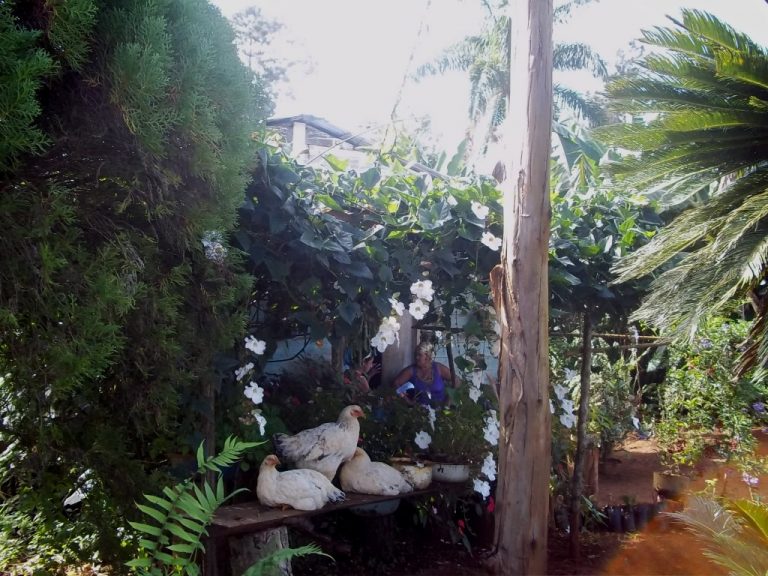
Fig. 4. Hens raised in the ornamental garden.
Some areas are being reforested with precious woods, such as majagua (Talipariti elatus) and cedar (Cedrela odorata). The National Forest Development Fund (FONADEF) is offering funds for this activity.
The education system in Cuba is free and compulsory until 9th grade. The rural communities in RBCT have primary schools (Fig. 5), however the access to schools is difficult because of the great distances from farms to the schools (between 1 to 10 km and more). To overcome this situation, many children go to boarding secondary schools (7th to 9th grade) from Monday to Friday, so that, during the school year, they don´t need to go back home every day but just on weekends. The government gives boarding students free food and accommodation.
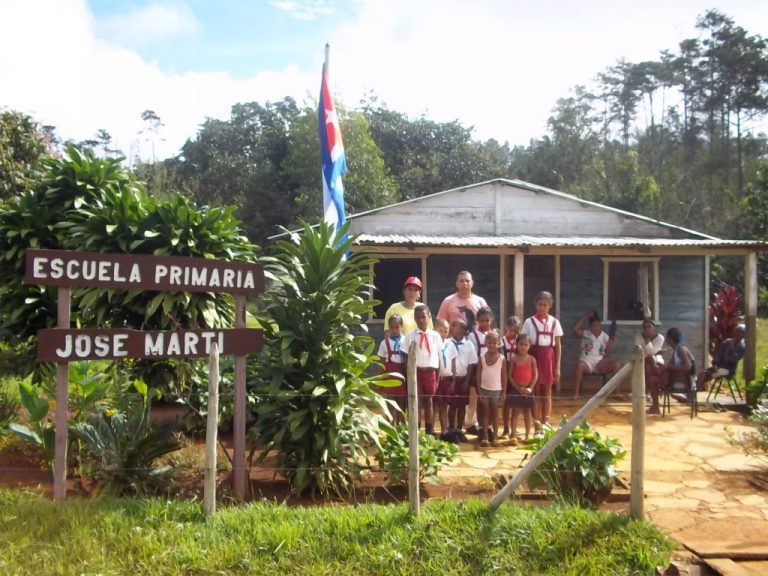
Fig. 5. Primary school at La Munición Community.
Medical care is also free and its structure includes family doctors (based in the communities), policlinics and hospitals (with medical specialties), which are respectively located in towns and cities. Access to medical services in polyclinics and hospitals is also difficult for the inhabitants of the transition area, because of the long distances from their farms (from 10 and 25 km to the polyclinics and 40 km to the hospitals, or even more).
Water used by residents is obtained from natural sources (rivers, streams and springs), and sometimes they have to take it from long distances (Fig. 6). The energy for food processing is also taken from natural sources as dry wood obtained by vegetation around the area.
Fig. 6. Farmer taking water to his home.
Residents have no electricity, but most of the communities have power plants that provide energy for 4 hours per day. In the communities, there are video rooms which are used to see television or movies, also to meet people, and as libraries. However, these community centers lack of instructional materials, which is highly demanded by farmers.
On the other hand, the distance to the nearest road sometimes varies from 1 to 12 km. The most important source of information for the communities is the battery-powered radio.
3.2 Use and management of agricultural and natural resources
More than 60 species (wild and cultivated) are used by rural communities in the transition areas of RBCT. As for crop species, around 80% are local landraces. The most important examples are shown in Table 1.
In addition, farmers conserve and protect natural forest species because of multiple benefits that they provide. Timber species like cedar (Cedrela odorata), majagua (Talipariti elatus) and royal palm (Roystonea regia) are usually used in the construction of houses. The royal palm is considered the Cuban national tree (Fig. 7) and not only is it used for timber, but farmers also use the leaves to build roofs both for houses and seed stores, which allow maintaining cooler temperatures. Royal palm fruits are used to feed pigs, while leaves of petioles (called yaguas) are used as division fences, or as umbrellas and for other uses.
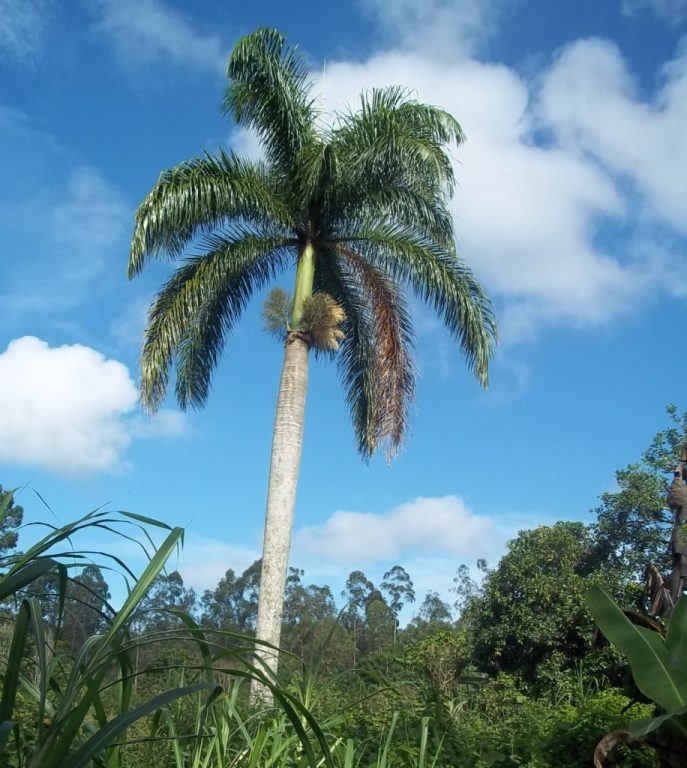
Fig. 7. The royal palm (Roystonea regia), Cuban national tree, frequently observed in the island.
Table 1: Cultivated species commonly used in traditional systems
| Category | Species | Crop | Landraces and commercial varieties (`´) more frequently used by farmers | Primary use | Other uses |
| Roots and tubers | Manihot esculenta | Cassava | Señorita, Jagüey dulce | Human food | Animal feed |
| Ipomea batatas | Sweet potato | Cien días | Human food | Animal feed | |
| Dioscorea cayenensis | Yam | Blanco, Sin fin, Amarillo, Morado, Amarillo-blanco, Caballo, Ñame pinareño | Human food | — | |
| Musa spp. | Banana and plantain | Tradicional inmune, Plátano fruta | Human food | Animal feed | |
| Colocasia esculenta | Taro | Isleña blanca, Isleña morada | Human food | Animal feed | |
| Grains | Phaseolus vulgaris | Common bean | Negro 60 días, Colorado, Blanco, Mantequilla, Sangre de toro, Negro 70 días | Human food | — |
| Phaseolus lunatus | Lima bean | Pinto, Colorao, Rojo, Enano, Pintico | Human food | — | |
| Zea mays | Maize | Criollo, Serra, Argentino, Cuña, Canilla, Pinto, Morado | Human food | Animal feed | |
| Vegetables | Brassica oleracea | Cabbage | ´KK-cross´ | Human food | Animal feed |
| Cucurbita moschata | Pumpkin | NLN | Human food | Animal feed | |
| Capsicum annuum | Pepper | Cachuchón, Chay, Ají chino, Ají calilla, ´Español´ | Human food | — | |
| Lycopersicon esculentum | Tomato | ´Vita´ | Human food | — | |
| Fruits | Citrus aurantium | Orange | Agria | Human food | Animal feed |
| Citrus sinensis | Orange | ´China´, ´Valencia´ | Human food | Animal feed | |
| Citrus limetta | Lime | NLN | Human food | Animal feed | |
| Citrus limon | Lemon | Criollo, Francés | Human food | — | |
| Citrus reticulata | Tangerine | NLN | Human food | Animal feed | |
| Psidium guajava | Dwarf guava | Guayaba enana | Human food | Animal feed | |
| Annona muricata | Soursop | NLN | Human food | Animal feed | |
| Mangifera indica | Mango | Filipino, Jobo, Manga blanca | Human food | Animal feed | |
| Persea americana | Avocado | ´Catalina´, ´Wilson´ | Human food | Animal feed |
NLN: No Local Name
In the case of plants for energy purposes, dead and fallen branches are collected from forests (Fig. 8 ) and supply around 95% of fuel required for human food processing and, in some cases, to prepare food for domestic animals. This activity provides some important environmental benefits because it avoids the excessive accumulation of dry matter in the forest, which prevents fire occurrences. At the same time, they protect some species of medicinal use such as copal (Protium fragrans), manajú (Reedia aristata) and others. The forest vegetation is also used as a natural shade for coffee (Coffea spp.).
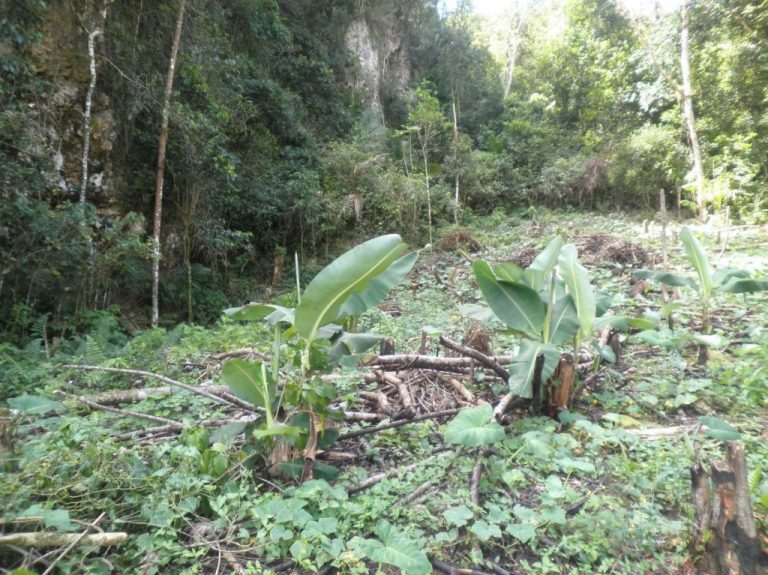
Fig. 8. Dead and fallen branches collected from the forest.
Farmers conduct agro-ecological management practices that greatly contribute to the sustainable production in these systems. For example, they take advantage of crop residues and animal manure to produce compost and vermicompost, retain water (empozar agua), and collect rainwater for agricultural irrigation and domestic use, which avoid the over-explotation of groundwater sources.
Farmers use intercropping techniques, mainly combining beans (Phaseolus vulgaris) and maize (Zea mays) (Fig. 9). They also use traditional methods to prevent soil erosion, such as ‘trenches on slopes’ and ‘dead or alive barriers ‘, and set-up forest species nurseries to prevent the decrease of their populations. In general, farmers have the perception that these practices help to close nutrients, water and energy cycles in their farms without depending of external inputs, thus maintaining a favorable environment for life.
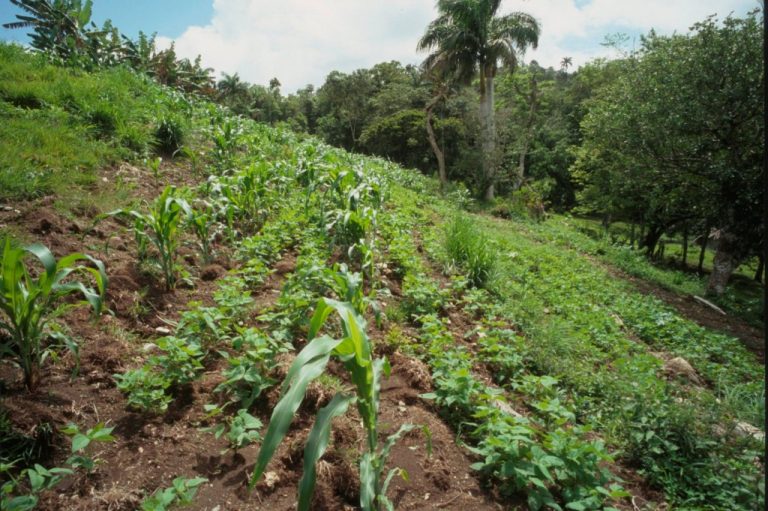
Fig. 9. Hillside cultivation (intercropping of beans and maize) following the level curve to avoid soil erosion.
3.3 About traditional knowledge and the role of gender in its transmission
Traditional knowledge is very important to develop sustainable livelihoods in rural communities. The ability to use available resources, the respect and the understanding of their values and knowledge transmitted from one generation to another is the central axis to the relationships with the natural environment.
Rural communities have a vast traditional knowledge regarding the practices and traditions of use of local variability which guarantee, often unconsciously, the balance of the systems that they manage. Farmers have made their farms produce for years, thanks to the knowledge inherited from their predecessors. This knowledge, regarding the use, management and biodiversity conservation is still being transmitted to younger members of the family, as many of them express their willingness to remain on their farms.
The recognition of local knowledge is a great support to raise the farmers and their family self-esteem. Women have well-established functions within the family, such as housework, child care and their education. In addition, they take care of medicinal, ornamental and condimental plants in the home garden and some of the domestic animals, as chickens, ducks, geese, pigs, dogs and cats.
Many of the species on farms are the result of families’ traditional knowledge. For example, some species are used for medicinal purposes such as copal (Protium fragrans) used against human cold and arnica (Odontonema strictum), for kidney diseases. Among the ornamental plants there are the flowering pinion (Gliricidia sepium) and garden pepper (Capsicum annuum), and there also are plants with magic-religious purposes, as win battles (Koanophyllum villosum), which provides farm prosperity.
Some handicrafts such as pickles are prepared by farmers using hot pepper (Capsicum frutescens) (Fig. 10) but also beverages such as pru, a typical beverage used in Eastern Cuba, which is made using five different species (roots, leaves and barks) that grow in the natural forest, but the pru has been commercialized in the last years (Fig. 11) and the used species could be in danger, especially those used for the roots. As for typical meal, an example is congrí, made with rice and frijol del diablo (devil bean), and eaten only at Christmas.
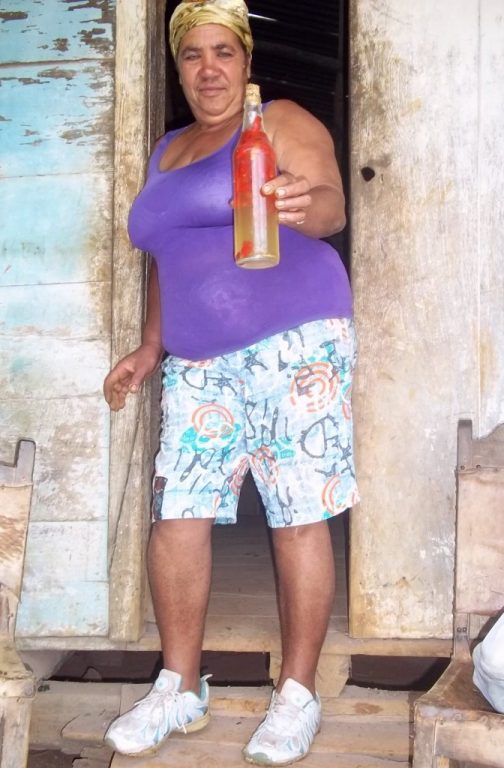
Fig. 10. Farmer woman from a RBCT community showing a handicraft pickle prepared by self in her house using hot pepper (Capsicum frutescens).
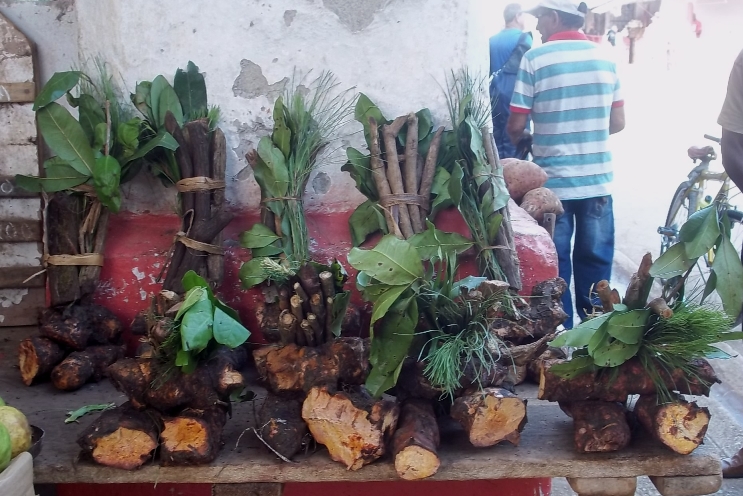
Fig. 11. Commercialization of pru in a Guantanamo City market.
Near the farms, some sacred sites have been found by farmers; they venerate and protect them, as in the case of a cave known as the ‘Virgin´s Cave’, where there is a spring of pure water.
Rural schools are another way to transmit the traditional knowledge to the young members of the communities. In primary and secondary schools, address topics like ‘The World that We Live’, and others which are related to biodiversity protection and management. Workshops are also held by RBCT environmental education specialists. School gardens are created in order to familiarize children at an early age with the crop care so that they can recognize and respect the work of their parents on the farms.
The understanding of local terminology in the transmission of knowledge is a very important aspect. In Cuba each region is characterized by different language peculiarities. In the Eastern region some terms have been created over generations and they are still used today, for example: sao (means weed), foguiao (very used cultivar), bomba (artisanal vinegar) and sambumbia (pickled peppers), just to name a few. These terms can have different meanings in other Cuban regions. Surely, these terms are not used exclusively in the RBCT mountains, where these communities are located, but they are often used by inhabitants of more urbanized areas in the region.
3.4 Restoration of natural and managed ecosystems.
Cuba is located in a geographical area particularly vulnerable to climatic shocks; each year the island is affected by tropical storms and hurricanes, many of which cause serious damage to crops and natural diversity because of their intensity (PMA-IPF-Cuba, 2001). The crops which are most affected by the loss of foliage caused by the onslaught of the winds are avocado (Persea americana) and tall herbaceous crops like banana (Musa spp.), coffee (Coffea spp.) and maize (Zea mays) (Fundora-Mayor, 2011).
There are other risk factors (abiotics and biotics) such as periods of heavy and prolonged rainfall (sometimes associated with hurricanes), prolonged droughts, pests and diseases such as blight (Alternaria solani), armyworm (Spodoptera frugiperda), mealybug (Pseudococos sp.), which basically affect tomato (Solanum lycopersicum), beans (Phaseolus vulgaris), sweet potato (Ipomoea batatas) and cabbage (Brassica oleracea var. capitata).
Although there are plans to address and mitigate the damage caused by these phenomena, many times the intensity is high and does not permit a quick recovery. However, complementation of in situ and ex situ conservation from local resources has been one of the working strategies of scientific institutions linked to conservation of national genetic resources. This way, damaged farming system could restore the agricultural diversity they had lost – that is the case of landraces of Phaseolus beans, dwarf guava and white pepper (Pimienta dioica). The natural vegetation is reforested with natural species that have been lost or are threatened.
Usually, in order to restore the landscape, farmers develop their own initiatives: they use dead wood from forests, exchange traditional seed varieties produced and stored by themselves quickly re-plant short-cycle crops and use crop remains for animal consumption or compost production.
Almost all farmers are willing to introduce new agricultural variability and technologies, to recover their agricultural systems and obtain economic benefits for their families. Both traditional and commercial variability coexist in the farms (although local landraces are always most frequent) which ensure the production sale in the market, especially in urban markets. So, farmers sow commercial varieties such as ‘Verano 1’ pepper, ‘Velasco’ bean and ‘KK-cross´ cabbage, and at the same time they use local landraces as Cachuchón pepper and Camagüey bean, between others. They planted neem trees (Azadirachta indica) with a dual purpose, as bio-insecticide and to provide shade for other crops, they use Rhizobium strains to provide nitrogen fertilization in the agricultural fields and also use inert materials (such as sand, ash and zeolite) to store grain.
3.5 Integration of different actors in the resource management.
The resource management involves different government organizations that contribute to the sustainable development of the RBCT. The SNAP organization (which belongs to CITMA) manages directly the natural resource heritage of the Reserve and the conservation and management of agricultural resources. The latter activity is also managed by MINAG.
The NGO “National Association of Small Farmers” (ANAP) is an organization whose members are small farmers and their families. The objective of this organization is to improve the farmer´s welfare and culture. The ANAP is involved in formulating policies and strategies regarding the agricultural land and production, as well as in the economy of this sector. For these reasons, ANAP cooperates with national institutions to coordinate productive technical and socio-cultural development programs that are implemented in rural communities. Their base organizations are the Cooperatives of Credit and Services (CCS) and the Agricultural Production Cooperatives (CPA).
CPAs are economic entities that represent an advanced and efficient system of socialist production and which have their own legal entity, incorporate land and other properties offered by small farmers. Other people also participate in order to achieve a sustainable agricultural production.
Most of the farmers in the transition area belong to the CCSs, which are voluntary associations of smallholders that retain ownership of the means of production and profits. It is a form of agricultural cooperation, encouraged by the state and with legal personality which guarantees technical, financial and material assistance by the Government.
Moreover, the aim of National Urban and Suburban Agriculture Program (PNAU / SU), led by INIFAT, is to support the relationship between production, training and the technical-scientific development of Cuban agriculture, with emphasis on the exchange and dissemination of knowledge, culture and local agricultural innovation. The foundations of the movement’s actions are developed on the basis of agro-ecological and territorial sustainability. It works on technical and technological updating of the production, on capacity building and on the direct link between producers, the final agricultural production and the marketing of their products. For this reason, the PNAU/SU Program is an opportunity for farmers to sell the surplus from their farm production after the family needs are satisfied, and to obtain agricultural technical training.
Farmers use the resources available in (or around) their farms in a sustainable way, so they consider themselves as guardians of natural diversity. However, intervention actions such as logging must be authorized by CITMA and MINAG.
3.6 Benefits to the local economy and human welfare.
The earnings obtained from these traditional systems are the main source of income for farmers, which satisfy most of their material and spiritual needs. Over 90% of the family diet in the RBCT communities comes from local landraces and domestic animals kept and maintained on the farms, with the exception of products such as rice, sugar and vegetal oil, which they get in state-subsidized stores or shops regulated by supply and demand.
The marketing of farm products is done through the CCS, by which the farmer contracts products like tomatoes, beans, peppers and cabbage, required by the state and for which the state sets the prices. The surplus of these crops and other farm products are sold according to a supply and demand mechanism both in markets or selling point managed by the PNAU/SU Program, located from 10 km (local markets) to 50 km (Guantánamo City).
Agricultural fairs are another marketing method recently established in the region and implemented with a frequency of 15 days. Such fairs have benefited farmers both through the sale of seeds and agricultural products, and also through the exchange of experiences with other farmers. In RBCT´s communities there are seed sharing networks, which allow the flow of different varieties and local landraces among farmers, a phenomenon that demonstrates the ability of informal systems to conserve crop genetic resources in time. Local governments and the formal sector are interested to continue performing these activities as a way to enhance the sustainability of rural areas and to ensure the food supply of urban populations. As a result of these efforts, some local landraces have been registered in the Cuban Register of Commercial Varieties, with the name of the breeding farmers as they solved problems after natural disasters or effects caused by biotic stress. The farmer insertion into the formal seed system guarantees some additional economic benefits to them.
4 – General Considerations.
Local diversity, traditionally used in the RBCT landscapes, is largely related to the farm sites which are located far from the cities in areas of difficult access, which has boost farmers and their families to search for alternatives for self-sufficiency. An improvement of living conditions in local communities, with more accessibility to basic services (health, education, communication, etc.,) as well as the improvement of economic benefits, could facilitate the retention of the younger generations in the farming communities and the transmission of traditional knowledge from one generation to the next.
Most of the farmers are receptive to new changes in their farms and they tend to introduce new variability and techniques to get higher yields and to increase the capacity of farm protection and recovery against different harmful factors (biotic and abiotic).
However, farmers think that access to information on new varieties and technologies, as well as on management of agricultural and natural resource is insufficient. They consider that it is necessary to create new spaces to exchange and share knowledge and to improve the management of cooperatives dealing with the marketing of agricultural products.
Moreover, there is a lack of diversity community records or other methods that allow the compilation of information on local variability, which is a threat to the conservation of traditional knowledge. The authors believe that the development of initiatives on the documentation of this gene pool would be of great value, and a key premise for conservation.
Knowledge is the most important aspect for plant breeding in Cuba, for the agricultural system that operates in the RBCT, but it is necessary to strengthen some aspects such as traditional knowledge rescue, technological capacity and training. That is the reason for supporting Satoyama Initiative, which addresses to the conservation, recovery and learning of traditional knowledge associated with world socio-ecological production landscapes.
References
Berazaín Iturralde R., F. Areces Berazaín, J.C. Lazcano Lara & L. R. González Torres. 2005. Lista Roja de la Flora Vascular Cubana. Jardín Botánico Atlántico, Documentos 4, Gijón, 86 pp.
Fong G.A., D. F. Maceira, W. S. Alberson & T. Washter. 2005. Cuba: Parque Nacional “Alejandro de Humboldt” Rapid Biological Inventories Report 14. The Field Museum, Chicago, 368 pp.
Instituto de Geografía de la Academia de Ciencias de Cuba, Instituto Cubano de Geodesia & Cartografía e Instituto Geográfico Nacional. 1992. Nuevo Atlas de Cuba, ISBN 84-7819-007-4, 214 pp.
Instituto de Suelos. 1999. Clasificación genética de los suelos de Cuba. La Habana, 28 pp.
PMA-IPF. 2001. Análisis y Cartografía de la Vulnerabilidad a la Inseguridad Alimentaria en Cuba. Proyecto VAM-Cuba, Programa Mundial de Alimentos (PMA) e Instituto de Planificación Física (IPF), Cuba Año 38, 144 pp.
Fundora-Mayor Z., T. Shagarodsky, T. Tellería, L. Fernández, N. León, O. Barrios, L. Castiñeiras, F. Hernández, M. García, V. Moreno, R. Cristóbal, M. C. López, Y. González, Y. Sánchez, D. de Armas & G. Acuña. 2011. Estrategias campesinas para enfrentar eventos de riesgo en sus sistemas tradicionales. Agricultura Orgánica 1, in press.

